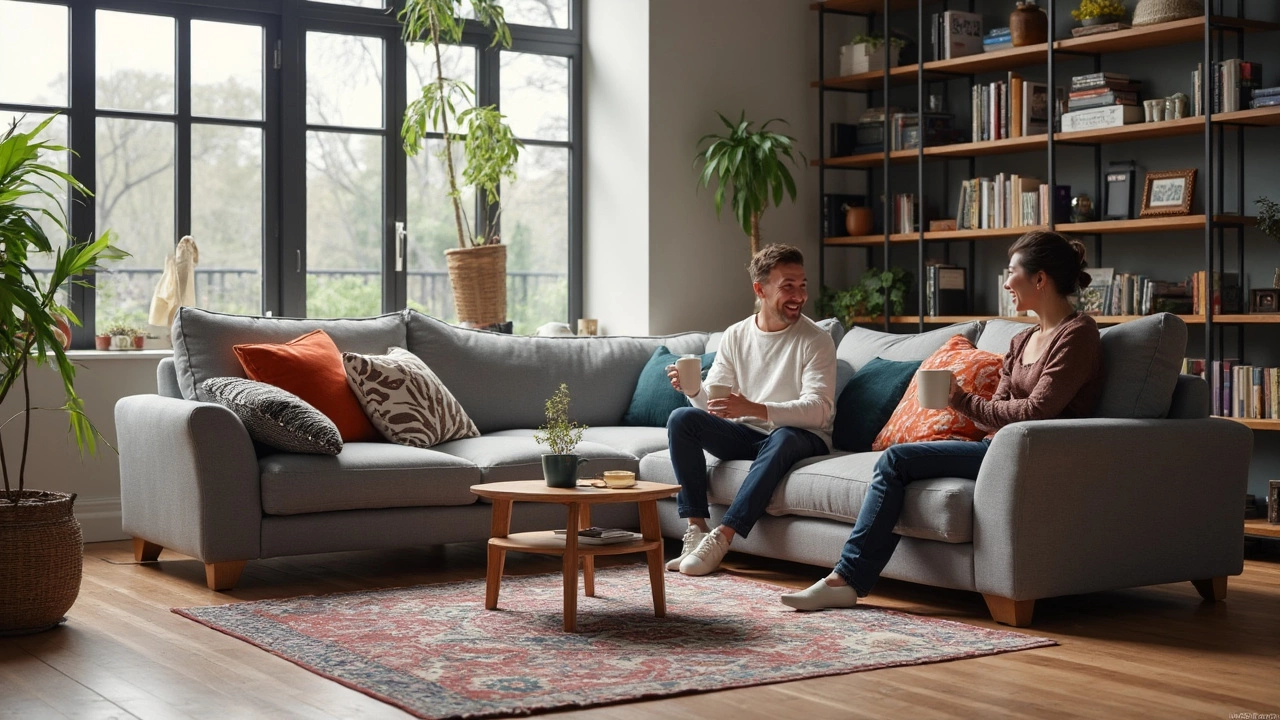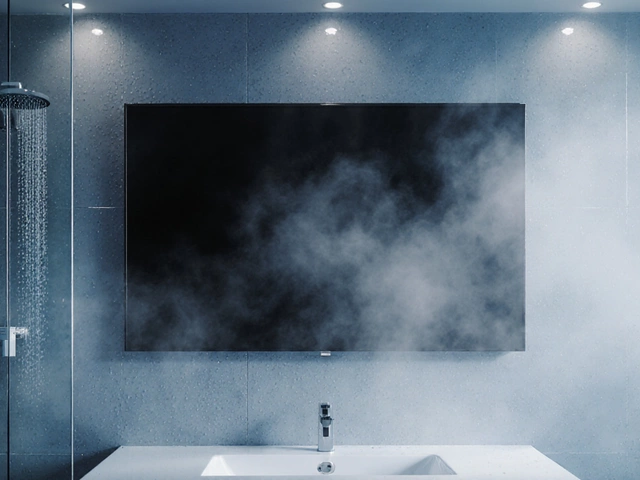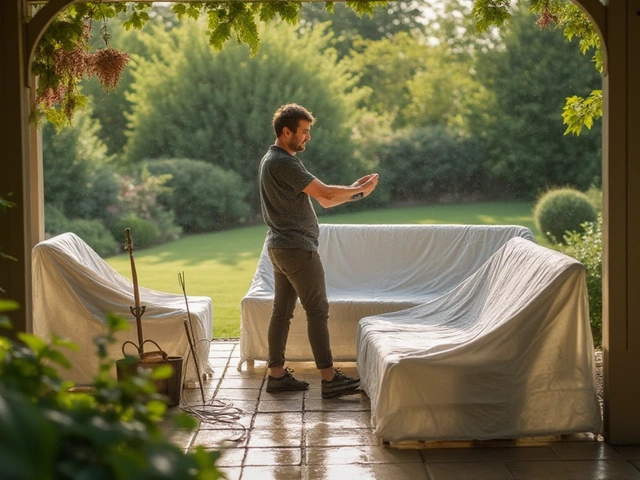Most people toss their corner sofas against walls and call it a day, but what if you rolled that thing out into the middle of your room? Sounds weird at first, right? Actually, it can shake up your space in ways you might not expect. We’re not talking interior-design show-off moves here—there are totally legit reasons for floating a corner sofa.
Before you start shoving furniture around, though, you’ll want to know the nuts and bolts of why this sometimes looks amazing (and sometimes… not so much). Curious how it might help your room flow better, or even make it feel bigger? Let’s break down the good, the bad, and the smart hacks that might just make your sofa the best thing in the house.
- Why Put a Corner Sofa in the Middle?
- When Does It Actually Work?
- Common Pitfalls (and How to Dodge Them)
- Styling Tips for a Standout Sofa
- Quick FAQ: Solving Sneaky Sofa Problems
Why Put a Corner Sofa in the Middle?
So, why would anyone want to drag their corner sofa away from the wall and park it right in the center? Turns out, there are some solid reasons—and it’s not just so your cat can hide behind it. Placing a corner sofa in the middle of the room can totally change the vibe and function of your space.
First, putting your sofa in the middle works wonders for open-plan living. If your living room bleeds into your dining space or kitchen, floating the sofa helps draw a clear (but invisible) line between zones without blocking light or views. It’s like setting up mini-rooms within one big room, and that makes everything feel less chaotic.
Want to make your sofa the star? Pulling it away from the wall instantly gives it more spotlight. This can turn a basic room into something that feels more put-together and intentional. Designers actually call this “anchoring” the space and it grabs attention.
Need a bigger walkway or want to use both sides of the sofa? Floating it lets people move around more easily. You can set up a walkway behind it or add a low console table for storage and style. No one likes squeezing behind a sofa jammed up against a wall—or tripping over Whiskers lounging in the shadows.
- Room divider: Great for lofts, studio apartments, or anywhere you want a bit of separation without using big, heavy barriers.
- Conversation focus: Sofas in the center make chatting easy since you’re not staring at blank walls.
- Light flow: Windows stay open for sunshine, so the room feels airier and brighter.
Check out the numbers below to see how many people are going for the floating sofa look:
| Year | % of Open Plan Homes With Floating Sofas |
|---|---|
| 2022 | 19% |
| 2023 | 23% |
| 2024 | 28% |
So, next time you wonder if your space could use a shake-up, consider pulling that corner sofa out into the spotlight. It can seriously up the style and function without much hassle.
When Does It Actually Work?
So, can you really pull off putting a corner sofa smack in the middle of your room? The answer depends on a few details, but when you get it right, it changes everything—more hangout space, a stronger room vibe, and sometimes, even better traffic flow.
Bigger living rooms with a clear, open layout work best. If you’ve got at least 1 meter (just over 3 feet) of walking space around the sofa, you’re golden. For smaller rooms, things can get tight fast and the sofa can mess with how you get around. Check out this quick table to see how much space matters:
| Room Size | Minimum Recommended Distance Around Sofa |
|---|---|
| Under 20 m² (215 sq ft) | Not recommended, unless sofa is compact |
| 20-35 m² (215-377 sq ft) | 80 cm - 1 m (2.6 - 3.3 ft) |
| Above 35 m² (377 sq ft) | 1 m or more (3.3+ ft) |
The main trick? Your room needs a focus. It can be a TV, a fireplace, a picture window, or anything else you want to highlight. Floating a corner sofa in the middle is perfect if you want to break up an open-plan space, like making a cozy TV spot in a huge living room/diner setup. It can also help separate a busy space for adults from a kids' play area, or a work zone from a chill spot.
Don’t just take my word for it. As interior designer Emily Henderson puts it:
“The best open-plan arrangements work because the furniture floats and creates actual rooms within big spaces.”
But here’s the kicker—it only works if the back of your sofa actually looks good. Some corner sofas have backs that are meant to be shown off, others, not so much. Before going for it, check that your sofa looks finished from every angle. A scruffy backside never did any sofa favors.
- Make sure the sofa anchors the space. Use a rug underneath to visually tie it to the rest of the room.
- Stick a console table or low shelf on the back for style and useful storage.
- Avoid placing it smack in front of a door—nothing worse than walking into the room and bumping into a sofa backside, right?
L-shaped and U-shaped corner sofas designed for open layouts look the best in the middle. Modular sofas also let you play around with the shape until it fits. If you nail these basics, your floating sofa will look totally intentional, not like somebody moved it while vacuuming and forgot to put it back.
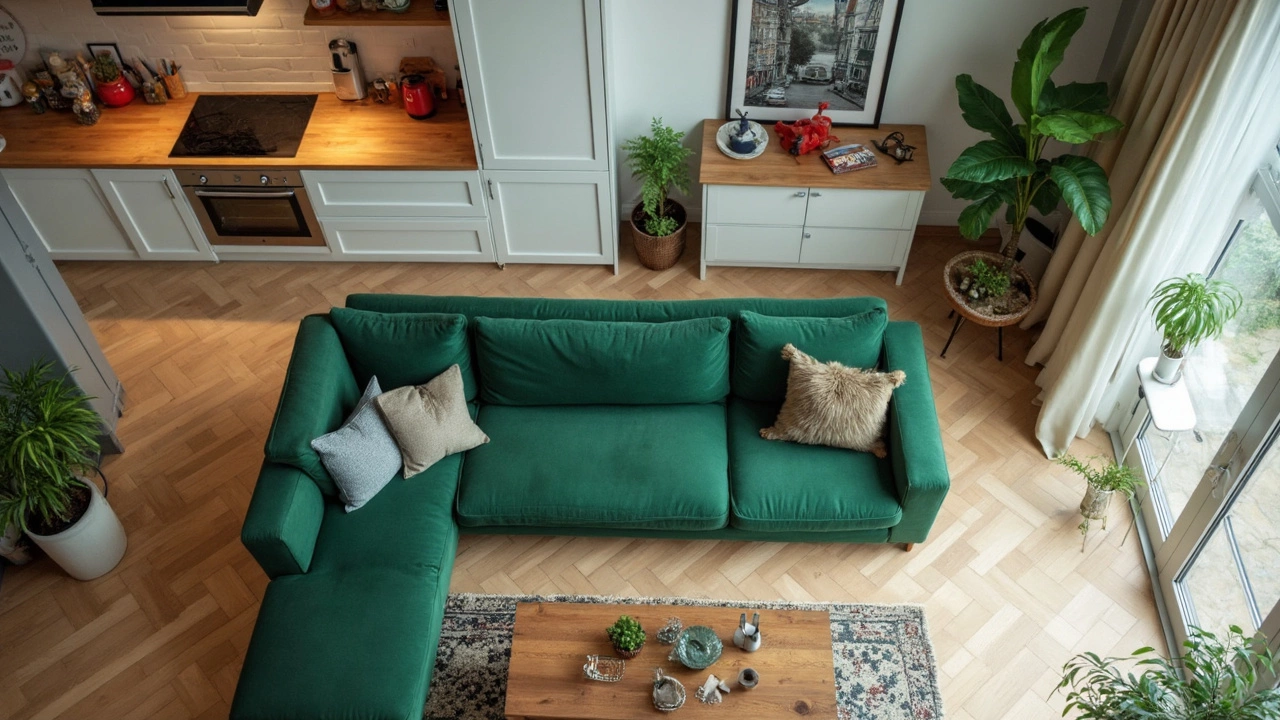
Common Pitfalls (and How to Dodge Them)
Plonking your corner sofa smack in the middle of the room might seem like an easy move, but plenty of people hit the same snags every time. You don’t want to end up tripping over cushions or blocking your TV, right? Here’s what usually goes sideways and how to fix it before you even get started.
1. Awkward Room Flow
When the sofa chops up the room, you can end up dodging corners or feeling boxed in. In fact, according to a 2023 Houzz survey, 41% of people who moved their sofas off the wall said it made foot traffic harder at first. The fix? Leave at least 90 cm (about 3 feet) of space around the edges. That way, nobody’s squeezing past or taking weird detours to their seat.
2. Lost Social Vibes
A corner sofa shouldn’t kill conversation. If everyone’s facing in one direction (hello, TV zombies), it’s easy to forget you have friends in the room. Try angling the sofa toward other seating, or pop an ottoman across from it to round things out.
- Face at least part of the sofa toward an entryway or window for an open feel.
- Use accent chairs or a coffee table to create a true social “island.”
3. Cable Chaos
Got lamps, a soundbar, or phone chargers? Cords can sprawl across your living space fast. The pros at Apartment Therapy recommend grabbing a roll of flat cord covers—they stick to the floor and won’t wreck your look. Plus, wireless lamps are actually a thing now, so you can save yourself some drama.
4. Weird Empty Gaps
A floating corner sofa sometimes leaves weird blank spots behind it. Instead of just hoping no one notices, plug the space with a console table, some big plants, or even your pet’s scratch post (my cat Whiskers loves his right next to our sofa!).
"A corner sofa can work anywhere if you think about sightlines and walkways first," says Emily Henderson, stylist and home blogger known for real-life solutions.
Here’s a super-quick visual if you’re thinking about moving furniture:
| Problem | DIY Fix |
|---|---|
| Can’t walk around the sofa | Leave at least 90 cm (3 feet) on edges |
| Room feels empty behind sofa | Console table, tall plants, or storage baskets |
| Cable mess | Flat cord covers or wireless gadgets |
| Social set-up is awkward | Add a chair or ottoman; orient sofa to face others |
Avoiding these pitfalls is way easier once you spot them coming. Just a few tweaks can help your corner sofa actually fit—and feel—right in the middle of your space.
Styling Tips for a Standout Sofa
When you put a corner sofa smack in the middle of your room, it instantly becomes the star of the show—no hiding it. But making it look awesome isn’t just about tossing a few throw pillows and calling it good. Here’s how to style it so your sofa looks like it belongs right where it is.
- Zone your room. Place a rug under or around the sofa to anchor it and separate it from other areas. Even a simple area rug will signal, “This is the chill zone.” The rug should be big enough to fit at least two sofa legs.
- Tame open space with a console table. Slip a narrow table behind the backrest for storing remotes, coffee cups, or even that stubborn stack of magazines. A table adds structure so the back of the sofa isn’t just a blank wall.
- Balance with lighting. Floor lamps behind one corner or a pair of matching side tables with lamps can keep it from looking lonely. Arc lamps work especially well with floating furniture—they shine light where you need it without cluttering the view.
- Build vertical interest. Don’t forget what’s above and around the sofa. Hang artwork or mirrors on nearby walls, or add a tall plant next to one end so the eye doesn’t just stop at the back cushions.
- Pillows and throws. Mix up patterns and sizes—don’t just toss three identical pillows and walk away. Grab a few different textures. It not only looks better, but it invites everyone to sink in and stay awhile.
One thing’s for sure: if you style thoughtfully, your corner sofa can be the piece that ties everything together, not the weird kid sticking out at the school dance. If you’ve got pets—I’m looking at you, Whiskers—consider darker tones or throws that can take a little scratching. That’s practical and stylish in one move.
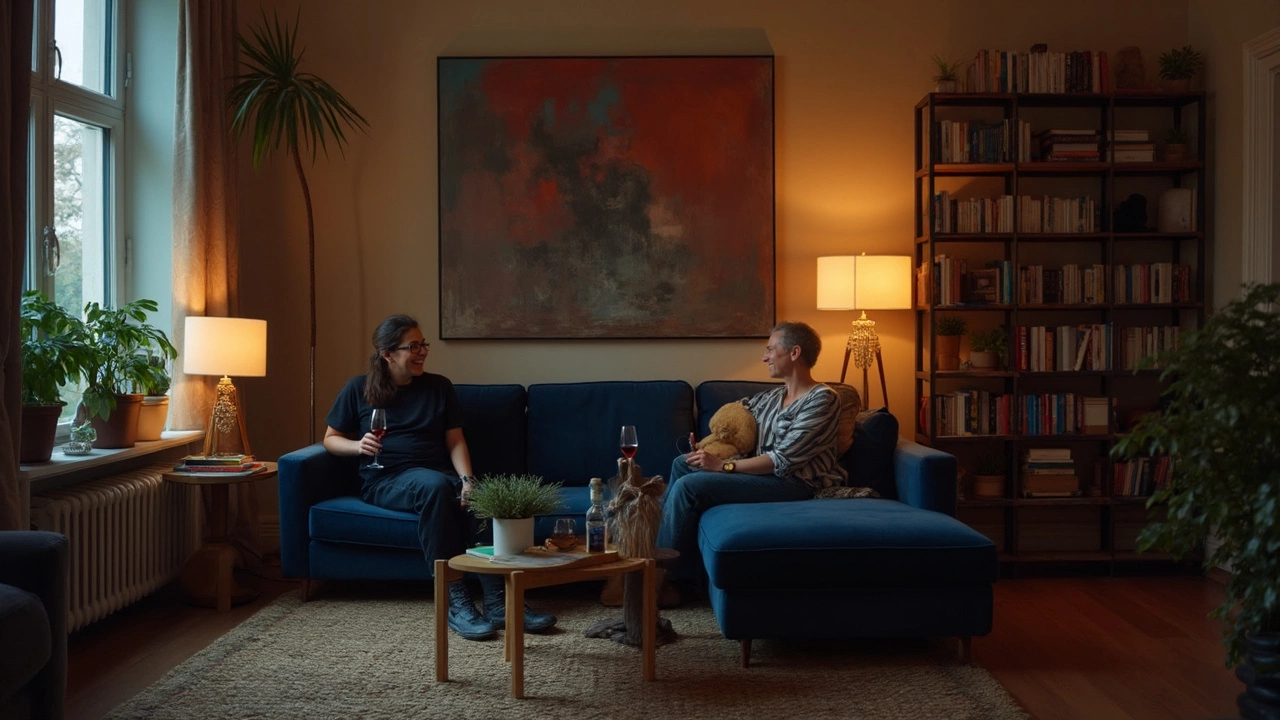
Quick FAQ: Solving Sneaky Sofa Problems
If putting a corner sofa smack in the middle of your room is giving you some doubts, you’re definitely not alone. People run into the same head-scratchers all the time. Here’s what you actually need to know about handling tricky situations:
- How do I stop my sofa from wobbling on carpet or hardwood?
If it wobbles, check the legs—sometimes one leg sits off because of uneven floors or old casters. Use self-adhesive furniture pads (or even a folded rug corner) under the shorter legs. For hard floors, gripper pads from the hardware store work wonders, keeping things steady and scratch-free. - What should I do about ugly sofa backs?
Lots of corner sofas weren’t made to be shown off from behind. If the back looks rough, throw a couple of big, neat blankets or a low-profile console table behind it. Add some baskets or books so it feels more intentional, not accidental. - Will my room feel cramped?
It depends on your floor space. Experts say you want at least 30 inches of walking space around any big furniture in open areas. Measure it out with tape—no need to eyeball and regret it later. - My pets love hiding under the floating sofa. Any fixes?
If you’ve got a cat (like Whiskers, who treats the under-sofa dark like his own lair), plug up the gap with low storage bins or some decorative baskets. That way, you keep dander and lost socks at bay. - How do I keep things tidy under a floating sofa?
Use a robot vacuum, since they duck underneath without fuss. Or pick an occasional cleaning day to sweep underneath. Try to avoid throwing stuff under there "for now"—it gets out of hand fast.
Here’s a quick data rundown to help you gauge a smart setup for your corner sofa:
| Room Size | Recommended Sofa Distance From Walls | Ideal Walking Space Around Sofa |
|---|---|---|
| Small (under 180 sq ft) | 12-16 inches | 24-30 inches |
| Medium (180-300 sq ft) | 18-24 inches | 30-36 inches |
| Large (over 300 sq ft) | 24+ inches | 36+ inches |
One last thing—don’t be afraid to move your sofa a couple of times before settling. Annoying? Maybe. But it’s better than living with regret when guests start tripping over the corners every time they visit.
